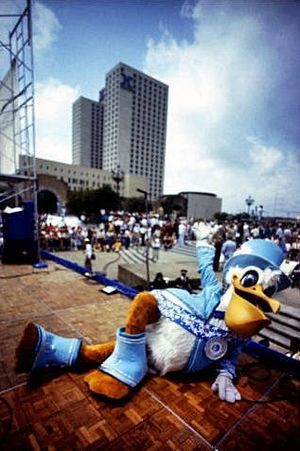1984 Louisiana World Exposition facts for kids
Quick facts for kids 1984 New Orleans |
|
|---|---|

Space Shuttle Enterprise at 1984 World Fair New Orleans
|
|
| Overview | |
| BIE-class | Specialized exposition |
| Category | International specialized exposition |
| Name | Louisiana World Exposition |
| Motto | World Of Rivers |
| Area | 34 hectares (84 acres) |
| Visitors | 7,335,279 |
| Organized by | Ralph Perlman |
| Mascot | Seymore D. Fair |
| Participant(s) | |
| Countries | 95 |
| Location | |
| Country | United States |
| City | New Orleans |
| Coordinates | 29°56′40″N 90°03′45″W / 29.94444°N 90.06250°W |
| Timeline | |
| Opening | May 12, 1984 |
| Closure | November 11, 1984 |
| Specialized expositions | |
| Previous | 1982 World's Fair in Knoxville |
| Next | Expo '85 in Tsukuba |
| Universal expositions | |
| Previous | Expo '70 in Osaka |
| Next | Seville Expo '92 in Seville |
| Horticultural expositions | |
| Previous | International Garden Expo 83 in Munich |
| Next | Expo '90 in Osaka |
| Simultaneous | |
| Horticultural (AIPH) | International Garden Festival |
The 1984 Louisiana World Exposition was a special event called a World's Fair. It took place in New Orleans, Louisiana, United States. This fair happened 100 years after New Orleans hosted an earlier World's Fair in 1884.
The fair opened on Saturday, May 12, 1984. It closed on Sunday, November 11, 1984. Its main idea, or theme, was "The World of Rivers—Fresh Waters as a Source of Life."
Even with its interesting theme, the 1984 Louisiana World Exposition had money problems. It was the only World's Fair to go bankrupt while it was still open. Many people think fewer visitors came because another World's Fair had just happened in Knoxville in 1982. Also, the 1984 Summer Olympics were happening in Los Angeles at the same time. Some also believe that Walt Disney World's EPCOT Center, which opened in 1982, drew people to Orlando, Florida instead. Since 1984, the United States has not hosted another World's Fair.
This fair was also special because it was the first World Exposition to have an official mascot. The mascot was Seymore D. Fair, a large white pelican in a costume. He became a very well-known character from modern World Expositions.
Contents
What Was at the Fair?
The fair was built on an 84-acre (340,000 m2) area along the Mississippi River. This area used to have old warehouses. The state of Louisiana spent $5 million to help create the fair.
Even though 7 million people visited, it was not enough to cover the $350 million it cost to host the event. Paychecks for workers started to bounce, meaning they couldn't be cashed. The government had to step in to make sure the fair could stay open until its planned closing date.
Fun Attractions
One of the most famous attractions was the Mississippi Aerial River Transit (MART). This was a gondola lift that carried visitors high above the Mississippi River. It took them from the fairgrounds to the Algiers area on the other side of the river.
The Space Shuttle Enterprise was also on display. Visitors could see this amazing spacecraft up close. The US Coast Guard's training ship, USCGC Eagle, was also open for tours.
Fair Location and Design
The fair was located right on the Mississippi Riverfront, near the New Orleans Central Business District. This area used to be a railroad yard. While the fair itself struggled financially, it helped improve the nearby Old Warehouse District. Many old warehouses were fixed up for the fair. These buildings later became shops and homes.
Even with its problems, many people from New Orleans remember the fair fondly. Some of the highlights included:
- A monorail for rides around the fair.
- The gondola that crossed the Mississippi River.
- An aquacade, which is a show with water and performers.
- An amphitheater for concerts and shows.
- The "Wonderwall," a unique architectural feature.
- The popular mascot, Seymore D. Fair.
There were also many places to eat, like the Italian Village and the Japanese Pavilion.
What Remains Today?
Some parts of the fair still exist in New Orleans. In the Warehouse District, many streets were improved. Old buildings were fixed up for businesses that hoped to serve fair visitors. These buildings are now used for shops and homes. These changes helped create the city's arts district that you can see today.
The Riverwalk Marketplace and the Ernest N. Morial Convention Center are perhaps the fair's biggest lasting impacts. The main exhibition hall of the convention center was the fair's Louisiana Pavilion. It reopened as a convention center in 1985.
Next to the convention center, you can find a large statue of Neptune, the god of the sea, and the head of one of his alligators. At the fair, these statues were part of the "Bridge Gate," one of the entrances. Most other fair buildings and the gondola system were taken down after the fair closed. The monorails were moved to Florida and are now used at Zoo Miami.
Even with its challenges, many New Orleans residents have good memories of the fair. They especially remember its unique modern buildings, like the Wonderwall.
On November 11, 2014, exactly 30 years after the fair closed, a special bronze plaque was put up. It is located at Julia Street and Convention Center Boulevard, which was the heart of the fair site.
Gallery
-
Worlds Fair New Orleans troll and child
See also
 In Spanish: Exposición Internacional de Nueva Orleans (1984) para niños
In Spanish: Exposición Internacional de Nueva Orleans (1984) para niños




